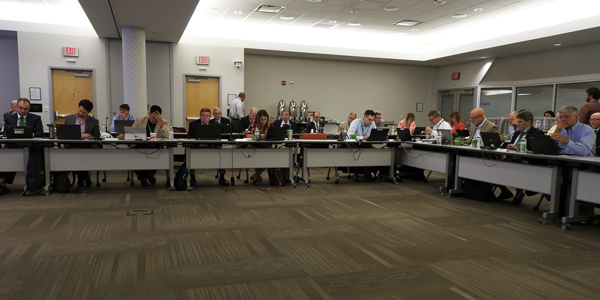Delay Approved for Cost Containment Comparisons
VALLEY FORGE, Pa. — The Markets and Reliability Committee last week agreed to a one-year delay in adding cost-containment measures to PJM’s transmission planning process as proponents made clear that their support of the initiative hasn’t wavered. (See Cost Containment Clears MC Vote Despite PJM Plea.)
“We’ve listened to PJM, we’ve heard PJM, and we want this policy implemented and designed correctly,” LS Power’s Sharon Segner said. “This motion could also be called a motion for excellence.”
The proposal, which pushes back the deadlines for implementing two comparative frameworks by a year, was endorsed by acclamation with three abstentions and one objection. The first framework, which will focus on construction costs, will be effective for transmission proposal windows commencing after Jan. 1, 2020. The second focused on return on equity and will be effective for windows after May 1, 2020.
Segner said the motion “in no way changes” the policy direction of the proposal that was endorsed by the Members Committee in June but was made in response to concerns from PJM staff that the original schedule would not allow enough time to ensure the initiative could be incorporated into the RTO’s Regional Transmission Expansion Plan. It does add detail to the implementation structure.
“There’s unfinished business from the June MC meeting that needs to be addressed in this motion,” Segner said.
“This is the right decision for excellence,” said Susan Bruce, who represents the PJM Industrial Customers Coalition and seconded the proposal.
She called for a “transparent” process and regular progress reporting from PJM staff “to reflect the fact that this is not delay for the sake of delay, but delay to get the rules appropriately crafted.”
Greg Poulos, executive director of the Consumer Advocates of the PJM States, was also supportive.
“It does add more competition to the market,” he said.
PJM Vice President of Planning Steve Herling agreed that the new timeline addressed staff’s concerns.
BTM Visibility

PJM’s Pete Langbein presented proposed Tariff and manual language to increase visibility of behind-the-meter generation, an effort to reduce load forecast errors and the impact of local load shedding.
The changes would create an annual process to model all BTM resources over 1 MW using Energy Information Administration data and transmission owner input. They would also allow TOs to coordinate with BTM generation owners during emergency load sheds to mitigate a grid emergency.
Several stakeholders objected to the proposal, which came out of PJM’s Distributed Energy Resources Subcommittee, being presented at the MRC as a first read. John Horstmann of Dayton Power & Light noted that while the language itself received 88% support at the subcommittee’s July 30 meeting, 58% favored retaining the status quo rather than make any change. Adrien Ford of Old Dominion Electric Cooperative also protested, saying the subcommittee had not discussed the vote before the proposal was sent to the MRC.
Committee Chair Suzanne Daugherty said she would consult Manual 34 to see if the proposal would require a second read at the next meeting.
Market Efficiency
The MRC approved a package of Tariff and manual changes that would alter how PJM evaluates and selects market efficiency transmission projects.
Under “Package G,” PJM would exclude from its base case generating units with facility study agreements and suspended interconnection study agreements. The RTO says including these units causes unrealistic benefit estimates for proposed transmission projects.
Package G received the most support out of nine proposals at the Market Efficiency Process Enhancement Task Force in July. It passed the Planning Committee with 88% in support at its Aug. 9 meeting.
Segner requested a sector-weighted vote on the proposal, calling excluding FSA units a “significant change” and saying she was concerned that PJM was favoring transmission over market-based solutions. It passed with 3.87 out of 5 in favor.
A second set of changes, which would specify that market efficiency proposals must address an RTO-identified congestion driver, passed by acclamation without discussion. Congestion drivers would include current or future market-to-market flowgates and internally binding flowgates.
VRR Curve Quadrennial Review
PJM’s Gary Helm confirmed that FERC has approved an extension until Oct. 12 of the RTO’s deadline to file the quadrennial review of the variable resource requirement curve in its capacity auctions. The extension allows time to push back approval votes as well.
MRC voters will choose among four proposals. Voters at the Market Implementation Committee heavily favored a proposal from Calpine. (See “Quadrennial Review of VRR Curve,” PJM Market Implementation Committee Briefs: Aug. 8, 2018.)
Calpine’s David “Scarp” Scarpignato questioned inclusion of a proposal from the D.C. Office of the People’s Counsel, but the OPC’s Erik Heinle defended it, saying “it’s not a new proposal by any respect” and it’s “been in the process” since it was unveiled at a July 6 special session of the MIC.
Awareness Issues
An initial review of proposed revisions to PJM’s governing documents proved controversial when American Municipal Power’s Steve Lieberman questioned inclusion of a requirement that stakeholders “properly” serve the RTO with rate and waiver requests filed at FERC. Lieberman noted that the change could put stakeholders at risk of being referred for FERC discipline for administrative errors.
PJM staff said the language is necessary to address clerical oversights that happen often enough to be an issue. PJM’s Jen Tribulski said it creates “a basis” for action if staff miss the deadline to intervene in a case or if an applicant is attempting to avoid allowing the RTO to weigh in on the issue.
Lieberman said the “change is rather substantive” and urged other stakeholders to consider its implications.
Interconnection Clarifications Approved
Stakeholders endorsed by acclamation revisions to Manual 14C that clarify procedures for construction of interconnection facilities for generation and transmission assets.
— Rory D. Sweeney and Michael Brooks




